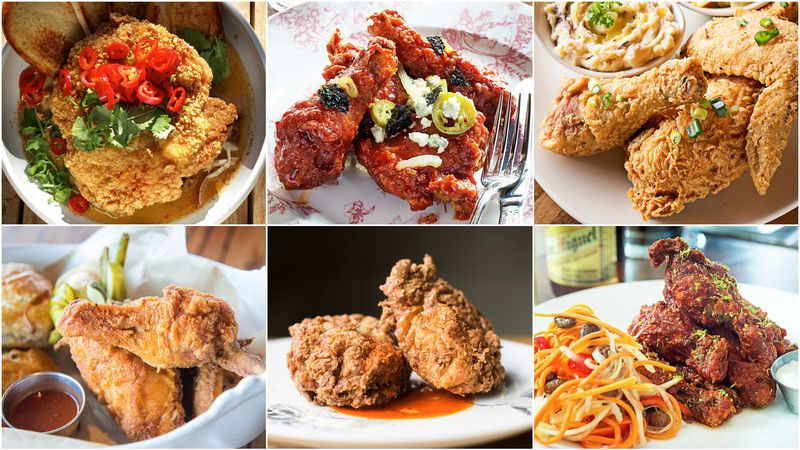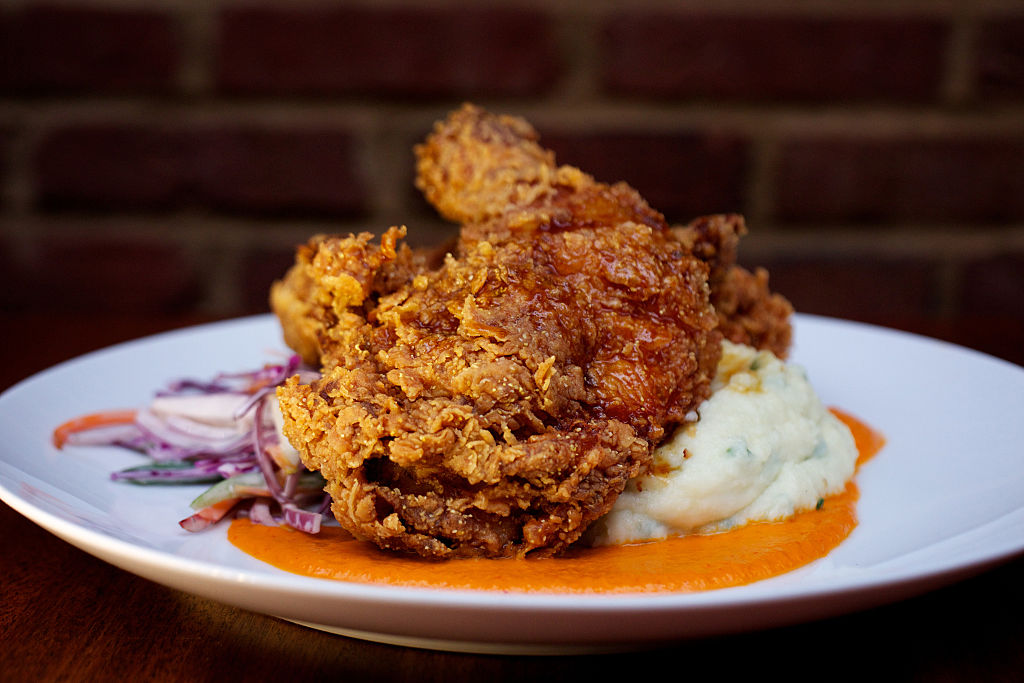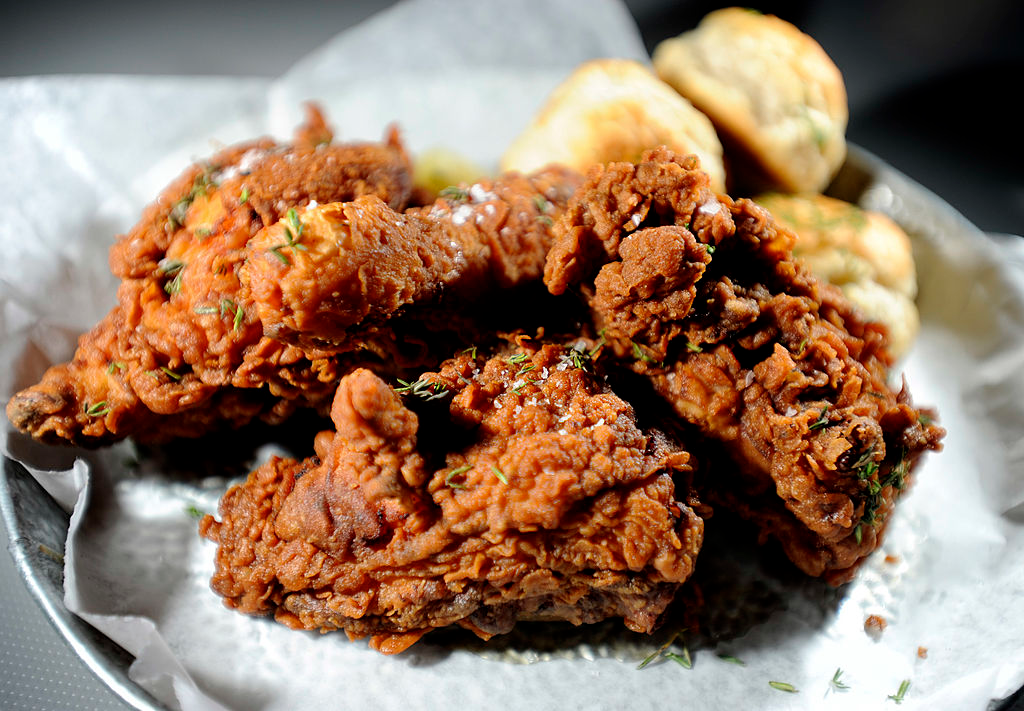The Secret To Great Fried Chicken: Dunk In Brine Before Dunking In Oil
Of all the pain-in-the-ass dishes to cook at home, fried chicken ranks high. But unlike, say, slaving over your kitchen for a chocolate soufflé, the labor-to-deliciousness ratio of frying chicken makes it worth your while. We've assembled the makers of some of our favorite variations of fried chicken across the country (as well as The Takeout and The A.V. Club staffers) for their favorite fried chicken tips and tricks.
Nick Melvin, executive chef of Venkman’s in Atlanta
Tip 1: Brine your chicken in a salt water and brown sugar brine for 24 hours or up to 48 hours before frying.
Tip 2: Once brined, poach chicken in a stock of equal parts chicken stock and dill pickle juice, until an internal temperature of 165 degrees Fahrenheit is hit. Once it hits 165, it should be chilled. Then you can proceed to bread and fry at 375. Poaching first does several things: It ensures that the chicken is fully cooked before frying, and thus a shorter fry time is required—you just have to fry until golden. Also, by poaching, it leaches out the blood vessels that normally turn people off of eating leg and thigh meat. Plus it adds another level of flavor to the final product.
Tip 3: Use a variety of breading. At the restaurant we use a mixture of all-purpose flour, cornmeal, rice flour, and cornstarch.
Ben McLean, executive chef of Leon’s Fine Poultry And Oysters in Charleston, South Carolina
What we do here is fairly simple. Our breading is two ingredients: seasoning and all-purpose flour. What really sets the chicken apart is to brine it. Brining is one of those things that's difficult for home cooks because of space, but it's the easiest first step of improving your chicken. We brine ours for four hours in a super simple mix of water, salt, sugar, and hot sauce. You can play with different aromatics—something like juniper, star anise, citrus peel, or even lavender is going to come across super subtle and nuanced. Guests over at your house will taste it on the tip of their tongue, and they'll ask, "What did you do to this chicken?"
The other thing that sets our chicken apart is that we bread our chicken the day before. Think for a moment when you've had fried chicken: You take that first bite of a chicken leg, and the whole crust pulls straight off the leg. It's a buzzkill. What we do is once we bread it, we let it sit on a rack in the fridge and let air circulate overnight. It'll allow the moisture of the chicken to soak through the breading, and it makes it super tacky, allowing the breading to stick to the meat itself. It creates a hard, crack-shell crust.
Jean-Philippe Gaston, executive chef of Izakaya in Houston
One of the best secrets to frying chicken is brining it first. In my kitchen we do a similar process, but it adds a ton of flavor and keeps the chicken juicy and tender. My mix is a combination of soy, sake, and fresh ginger. The soy to sake ratio is 3:1 and as much ginger as you would like. Bring the mix to a lukewarm state and pour over the chicken. I chop the chicken to 1-inch cubes. Let the chicken sit for three hours or so (if it stays too long, the soy will make it saltier by the minute). Strain it, but don't wash it. Toss in cornstarch and fry till it floats. This will give it a light and crispy texture so you can enjoy as much as you want.
Marah Eakin, The A.V. Club senior editor
I'll admit that putting butter on fried chicken sounds a little gross, but a friend who was versed in the ways of Chicago's Honey Butter Fried Chicken convinced me to give it a try, and now I'm hooked. The trick—besides moderation—is using good, whipped butter, with a little honey whipped in if possible. Take a bite, slap a dab on the meat, and take a bite. Repeat. I promise, you'll be convinced.
Joy Crump of Foode and Mercantile in Fredericksburg, Virginia
Tip 1: Keep the oil temp low enough that it cooks (but doesn't burn) the chicken, yet high enough to give your coating a beautiful, crisp exterior. I find that 325 degrees Fahrenheit is about right for boneless pieces, which tend to cook faster. Bone-in pieces need to spend more time cooking in the oil in general so you should drop the cooking temp to about 275 degrees. If you find that the outside looks great but the inside is still underdone (below 165 degrees on a thermometer), pull it out of the oil and finish cooking in a hot oven, about 350 degrees. That will continue to roast the chicken without over-browning the outside.
Tip 2: Pull your chicken from the fridge about 30 minutes before frying. Allowing the chicken to come up to room temperature before cooking ensures that the meat will cook faster, keeping up with the quick-cooking coating.
Tip 3: Season everything—the chicken, the marinade (buttermilk or a brine), and the coating. You don't want to spend time producing a wonderfully juicy piece of well-seasoned chicken only to dredge it in a flavorless coating.
Richard Hales, executive chef/partner of Bird & Bone at The Confidante Hotel Miami Beach
Mastering perfect fried chicken is hard; cooking at home makes it harder. It takes tons of room, it's messy, and it's downright dangerous. Your kitchen will look like a flour-filled war zone if you haven't burnt it down in the process. If you are still determined, here are a few tips for great fried chicken: Start with quality chicken—freshly butchered from a local farm is best if you have the access. Brine your chicken to create the juiciest chicken you have ever had. Once out of the brine, leave the chicken in the fridge uncovered for a day to dry out the skin. Dredge in flour but leave it there; the longer in the flour, the better the crust adheres to the skin. Never fry ice-cold chicken from the fridge. Let it come to room temp before frying. Oil should be at 350 degrees, and chicken will take about 12 minutes to bring the internal temp to 165 degrees. Always add a little finishing salt when it comes out, and you will have the best fried chicken you've ever had.
Kevin Pang, The Takeout editor-in-chief
Do as the Asians do: Experiment with a non-flour breading. The Japanese love using potato starch for fried chicken batter. It makes for a lighter exterior, which magically, holds its crispness even after sitting out at room temperature. The Chinese prefer cornstarch, which fries up a beautiful coating as well.
Danette Chavez, The A.V. Club assistant editor
My tip is pretty straightforward: I prefer my fried chicken without the breading. It's just the way I was brought up. My mom used to buy whole chickens at the grocery store and then take them apart in the privacy of her own kitchen before dropping thighs, drumsticks, and breasts into a frying pan. Add black pepper and some adobo seasoning, and you're good to go. Bonus: Cleanup is a snap.
John Shields, chef/owner of Smyth + The Loyalist in Chicago
To get a nice crust, bread your chicken, let it hang out in your fridge for a few hours, and maybe double bread after that. I've used the Korean technique of using cornstarch in there, too (2:1 flour-to-cornstarch ratio), and a half teaspoon of baking powder—I've used baking powder in my tempura, and it seems to add a lightness. In terms of oil, sometimes I like to use lard or garlic oil to fry my chicken in. It's always a bit different, but I definitely love flavoring oil. Even adding Benton's smoky bacon into the fry oil would be a great addition.


